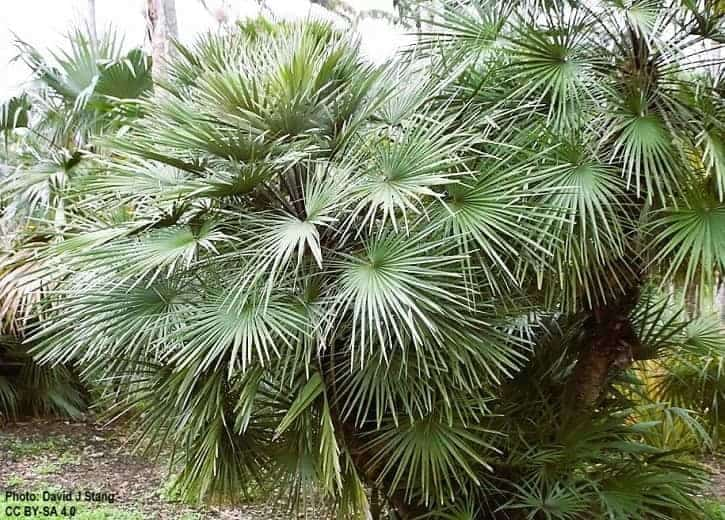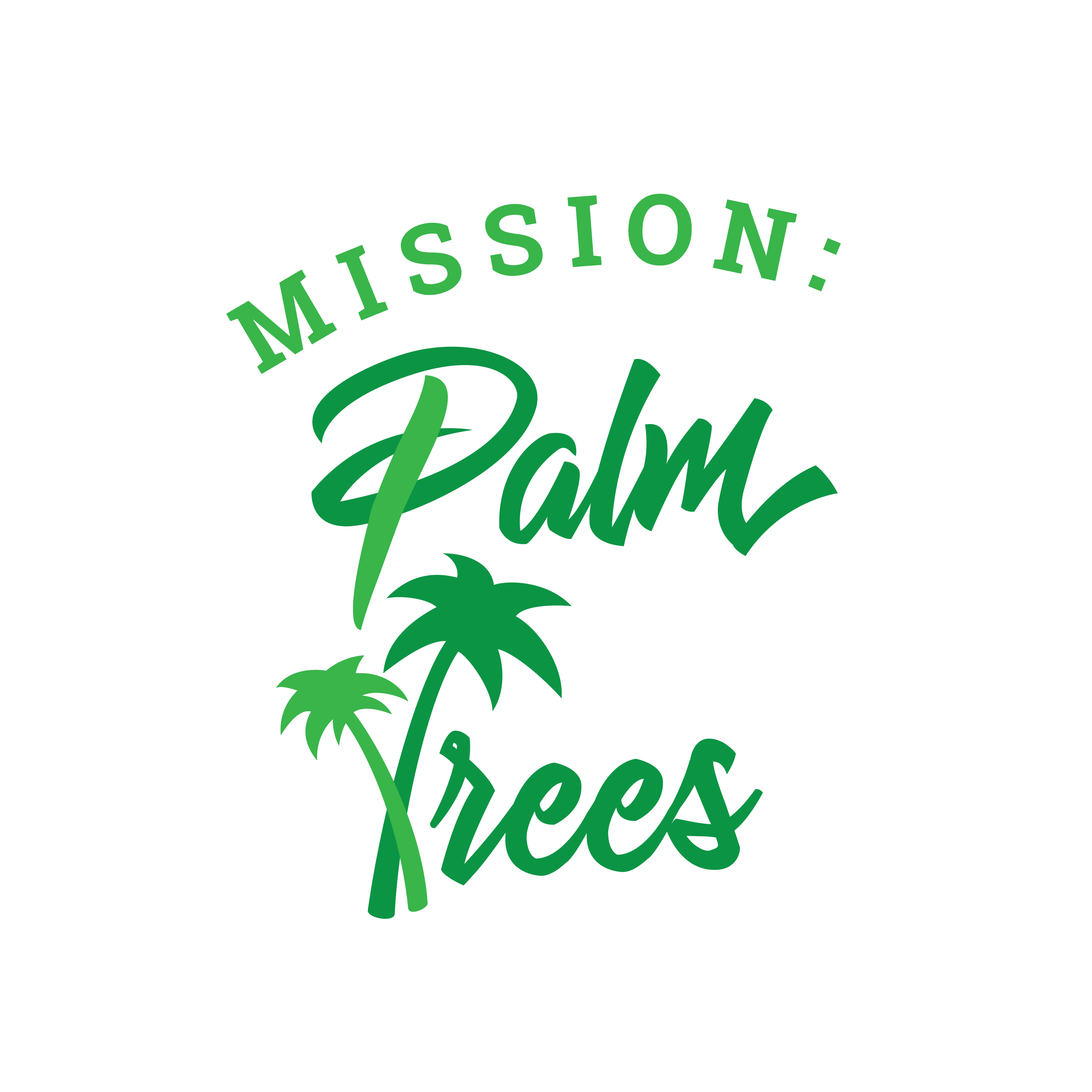- Home
- Landscape Ideas
- Backyard Palm Ideas
- Best Backyard Palms
Best palm trees
for backyard Landscaping & Gardens
Which are the best palm trees for backyards?
Is that what you're thinking? This guide helps for successful, happy, healthy palms in your backyard.
Picking a palm tree for your backyard is kinda like choosing your perfect pet.
- It’s important to match your landscape and climate with a chosen palm's needs
- Just as you make sure a pet’s temperament and upkeep fit into your home & family.
Basics for Deciding
The Best Palm Trees for Backyards
Don't be the person who regrets their palm choice! Be the person who researches thoroughly.
The best palm might not be what you expect. It could be the one that thrives in the most unexpected conditions!
Scroll down for Plant Care Practices the best palm trees for backyards.
You Want to Get Right to the Best Types of Palm Trees for the Backyard?
Whether Tall, Short, or Clustering to Spread out - What's Your Choice?
Feeling overwhelmed by so many palm trees?
You're not alone. We Understand your headaches! At Mission: Palm Trees you'll find clear answers to questions & Step-By-Step Guidance, from real people. With solutions to help. No puzzling shoptalk. No tiring research. So it's easy & fun for you.
Essential Palm Landscape Design Evaluation
For Your Backyard
First know your Growing Zone.
As the most success comes to those who plan, not those who guess.
For instance, where we live in the Sonoran Desert in Tucson Arizona's Zone 9a, we're restricted in palm choices because of the arid environment.
Consider the USDA Hardiness Zones
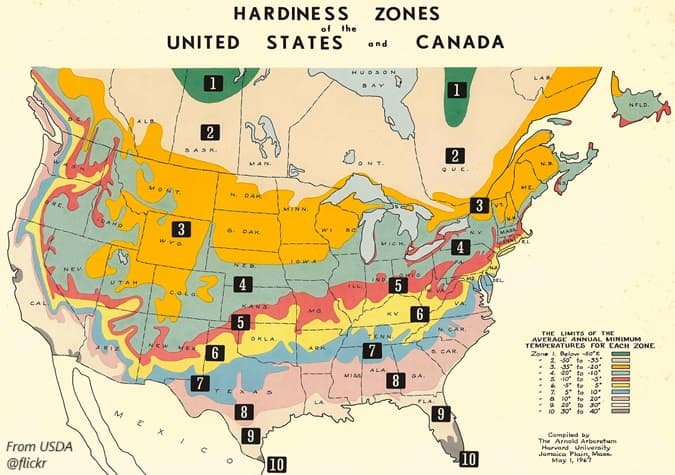
Find out Your Own USDA Hardiness Zone!
For your best palm trees, backyard success, personal satisfaction - Think of this:
- In South Florida, Tropical Plants like Coconut Palms excel because freezing temperatures are rare.
- In Southern California, where it doesn't get too cold, palms suited for mild subtropical climates are best.
- In temperate climates, Search Out Cold-Hardy Palms for those withstanding low temps.
Nearly all Palm Tree Resources tell you a palm's growing zone requirements. Some zones can overlap climates. Since alternatively, Your Garden's Microclimate may redefine your perfect palm's limits, rather than be confined by them.
Match that information to your Palm Purchase.
Maintenance Basics Of Backyard Palm Gardens
Palms need sunlight, water, and nutrition. But also do best planted in the right soil.
- Which means considering the Palm's Native Environment. Not just your desired planting location. Then you'll know a palm's sun requirements. Like partial shade, or full sun.
- Watering relates to palm origins. Nearly all palms need well-drained soil.
- Soils have natural nutrients. But good for your palm? Soil testing tells if, when & how you might Fertilize Your Palm.
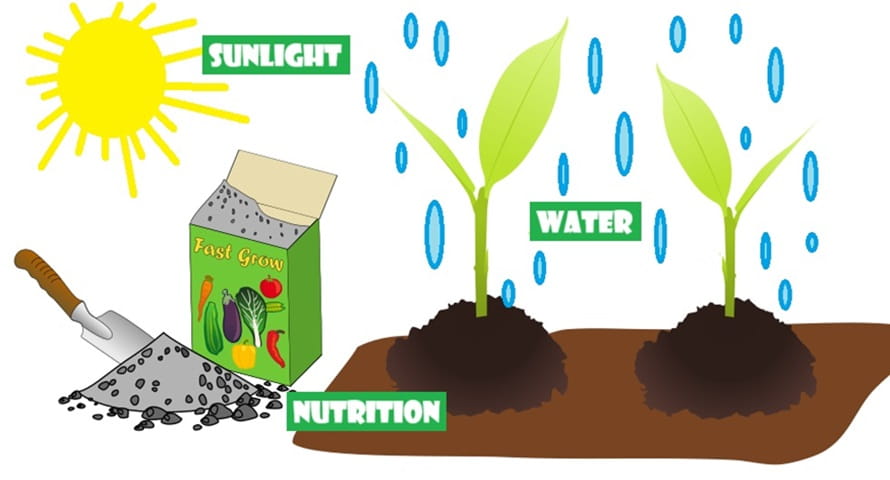
Best Palms to Choose for Your Backyard Landscape
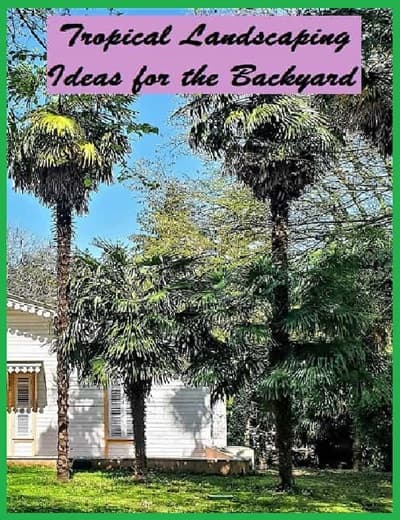
You've evaluated your environment & palm planting needs.
Let's find the best palm trees for your backyard. Local landscape clime, weather, & micro-climate factors are involved.
All this when Planning Your Own Palm Landscaping, for the best palm trees for backyards.
Check our Latest
-
Backyard Palm Tree Ideas Make Your Space Feel Like a Tropical Escape
Bring a resort feel home. Explore inspiring backyard palm tree ideas with themes like clustering, layering, and lighting designs for any space.
Best Palms for The Tropical Climates
Tropical climates include Planting Zones 10b through 13. Where lowest temperatures range from 35-40°F (-1.1-4.4°C). With hot summers.
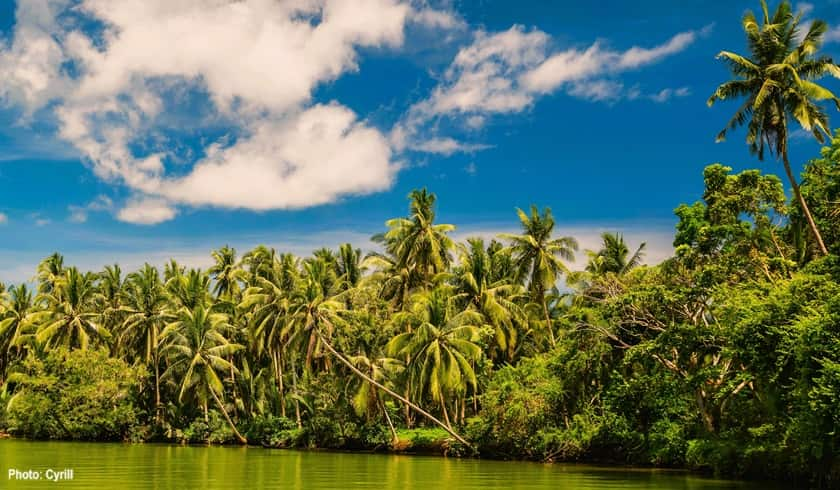 Can You Just Feel That Heat & Humidity?!
Can You Just Feel That Heat & Humidity?!Remember, arid climates in tropical zones don't support all the best palm trees for backyards. As do the humid, rainy tropics.
Best Backyard Tall Tropical Palms
Queen Palms are Pretty Hardy
Syagrus romanzoffiana, the Queen, grows beautifully if you provide plentiful water. Native to rainforests. Includes Zones 9-11. Even Zone 8 with caution.
- Gorgeous ringed trunk. Quickly as tall as 90ft/27m.
- Likes sunny areas all day.
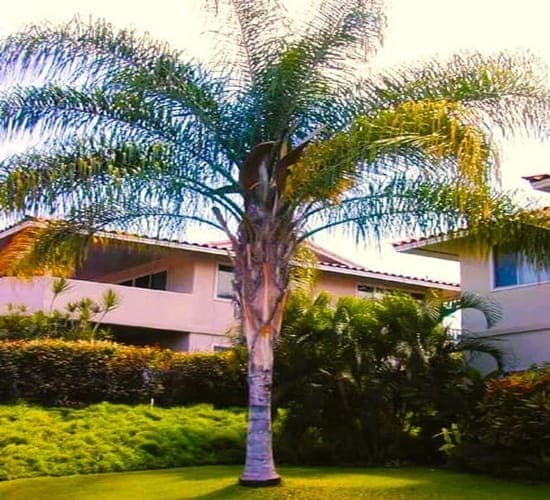 Queens Like Their Soil Amended With Humus - Photo: Picture This
Queens Like Their Soil Amended With Humus - Photo: Picture ThisGreat Choices for Smaller Tropical Palms
Hedyscepe canterburyana the Umbrella Palm
AKA Big Mountain Palm. Best in Mediterranean climates of zones 10-11.
- Likes some daytime shade. Some higher water needs.
- Slow-growing to 35ft/11m, patience needed! Plusses: the Maintenance Ease of a Crownshaft.
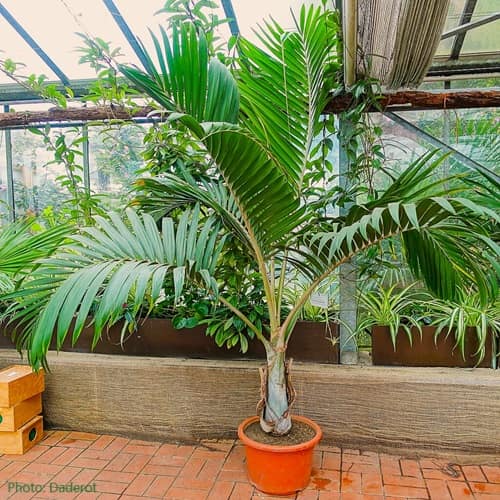 Dazzling Umbrella Palm, Flora Park Cologne, Germany
Dazzling Umbrella Palm, Flora Park Cologne, GermanyMiniature or Pygmy Date Palm
Phoenix roebelenii loves Zones 9b-11. Fine for 9a dry climates.
- To 15ft/5m tall. White flowers produce dates you won't want to eat!
- Light shade or full sun. But needs regular water.
- Our Tucson neighbor has triplets doing well in their front yard.
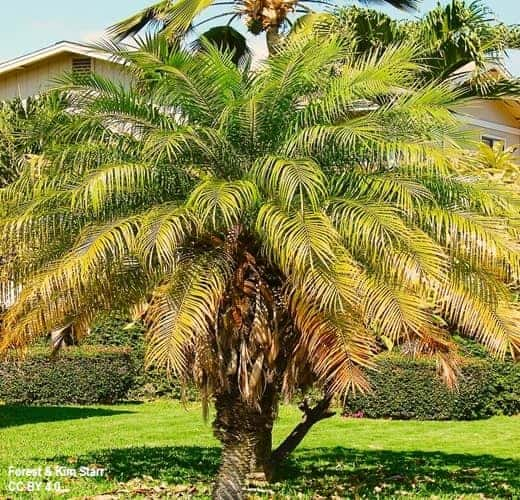 Growing Happily in a Hawaiian Climate
Growing Happily in a Hawaiian ClimateManilla Palm is a True Tropical Plant
Adonidia merrillii, best for Zones 10b-11.
- Also called "Christmas Palm" for red colors around December.
- Only gets about 20ft/6m high.
- Give consistent watering & mostly sunny location.
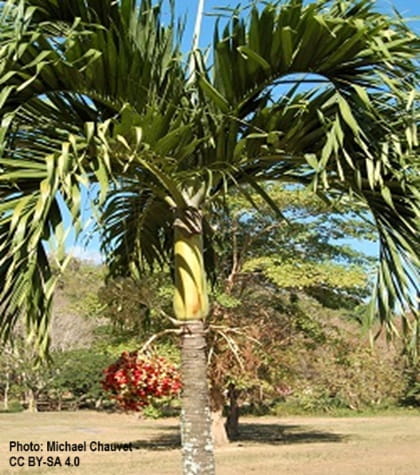 Manilla's Red Fruit Contrasting With Greens
Manilla's Red Fruit Contrasting With GreensPindo Palm - Fantastic Focus Plant
Butia capitata, this hardier sort, does well in Zones 9-11.
- Likes full sun. Moderate watering needs.
- Edible fruit, make jelly/jam from it. Naturally, also nicknamed Jelly Palm.
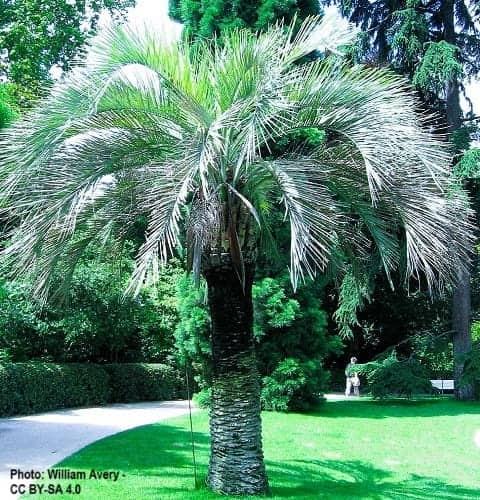 Gorgeous Example at the Royal Botanical Garden in Madrid
Gorgeous Example at the Royal Botanical Garden in MadridPinanga patula a full Feather Palm
Often Simply Called Pinang. Full crown of pinnate fronds. 10b-11 Zones.
- Medium growth to 15-19ft/4.5-5m.
- Best in part shade & consistent watering.
Try a Giant Windowpane Palm
Beccariophoenix madagascariensis grows 24-40ft/7-12m up. Best in Zones 10b-11. But 10a doable with caution.
- Just gorgeous! Likes some shady time.
- Native to Madagascar rainforests, loves water.
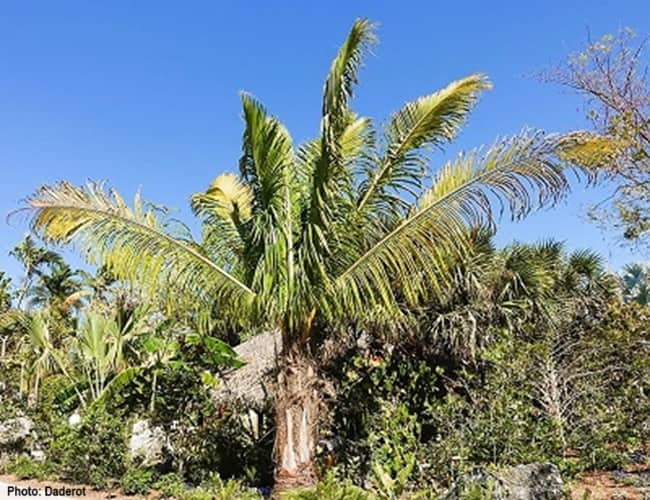 Giant Windowpane, Naples Botanical Garden FL
Giant Windowpane, Naples Botanical Garden FLBackyard Tropical Clustering Palm Trees
Orange Collar Palm - Truly Stunning!
Areca vestiaria often produces multiple trunks. Zones 10-11.
- Slowly reaches 20ft/6m tall.
- Showcases reddish crownshafts and red fruits.
- Prefers some daytime shade, plenty of water.
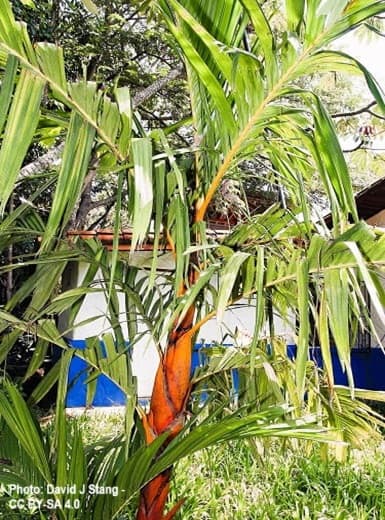 See its Colorful Crownshaft
See its Colorful CrownshaftElse Kientzler Botanical Garden.
In Sarchi Norte, Costa Rica
Formosa Palm Endemic to Taiwan
Arenga englari, best for Zones 9-11.
- Full sun, average watering.
- Caution: warn people from touching skin-inflaming fruit.
- Prevention: crop inflorescences when flowers dwindle.
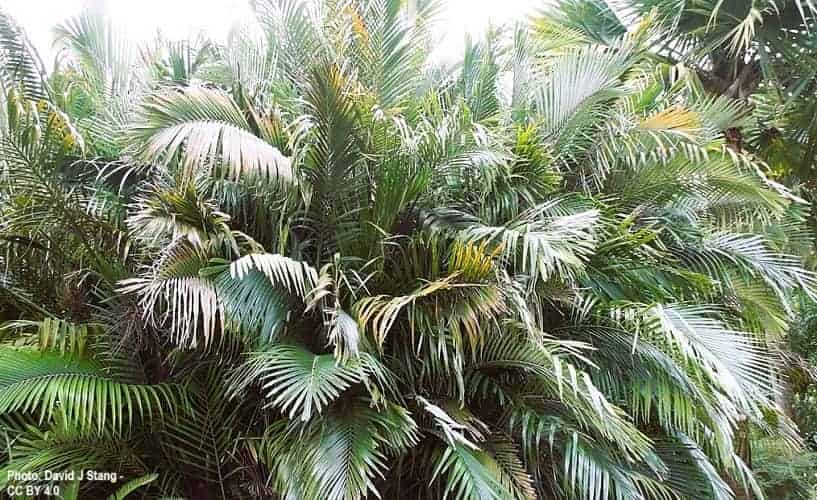 AKA Dwarf Sugar Palm, living at Fairchild Tropical Botanic Garden, Miami
AKA Dwarf Sugar Palm, living at Fairchild Tropical Botanic Garden, MiamiGolden Cane or Areca Palm
Dypsis lutescens, AKA Butterfly Palm. Successful in Zones 10-11.
- Thirsty! With quick growth.
- Crownshaft tops nicely striped trunk.
- Good for attractive (25-40ft/7.5-12m) screening.
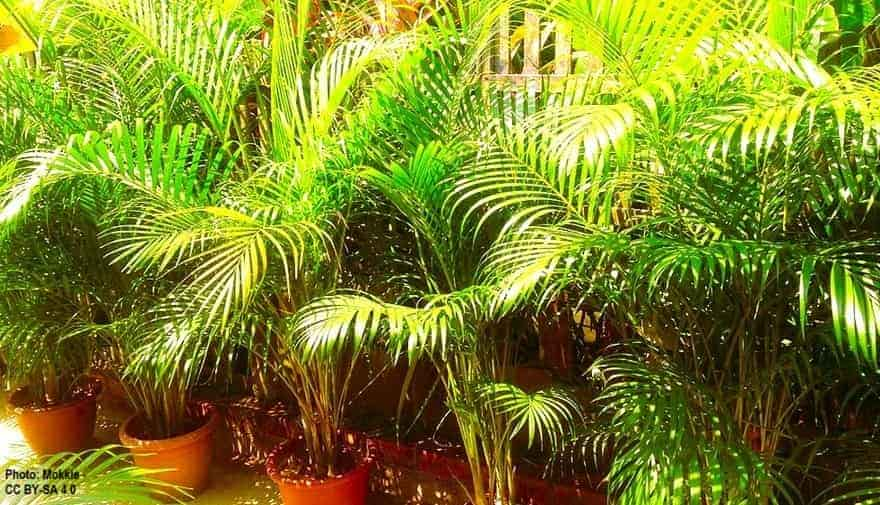 Areca Palms at the Nursery. Potted Up to Take One Home to Plant!
Areca Palms at the Nursery. Potted Up to Take One Home to Plant!Best Palm Trees for Subtropical Backyard Landscaping
Subtropical climate zones include Planting Zones 8-10a. Lowest temps go from about 20 to 35oF/-6.7 to 1.7oC.
Including arid zones. If that's you, Further Consideration Needed for best palms.
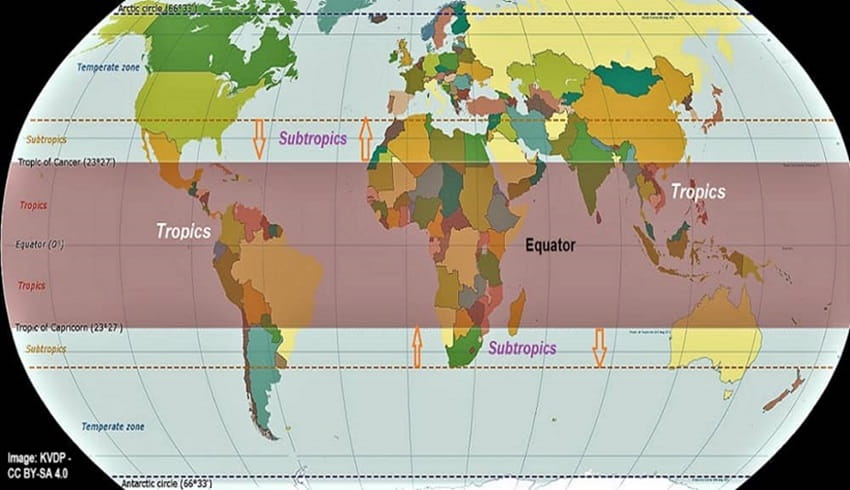 Earth's Subtropics are Above & Below the Tropics
Earth's Subtropics are Above & Below the TropicsSee These Tall Subtropical Backyard Palms
Peach Palm With Edible Fruit
Bactris gasipaes, for Zones 10-11. With your freeze-watch, okay for 9.
- Quickly to 60ft/18m tall.
- Sometimes difficult to find. Easier Growing It From Seed instead.
- Needs good sunny placement & generous watering.
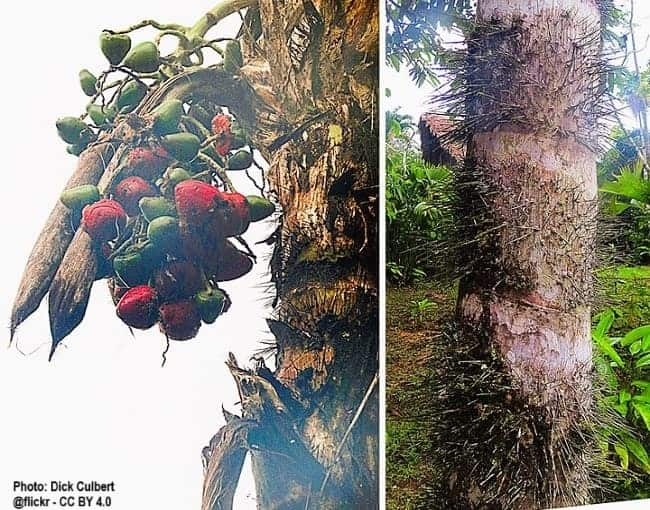 Be Cautious! Trunks have short, spiky rings. Ouch!! 😮
Be Cautious! Trunks have short, spiky rings. Ouch!! 😮Caranday Palm for Backyard Focus
Copernica alba does well in Zones 9b-11. Cautiously 9a.
- Quickly can get 80ft/24m tall.
- Average watering.
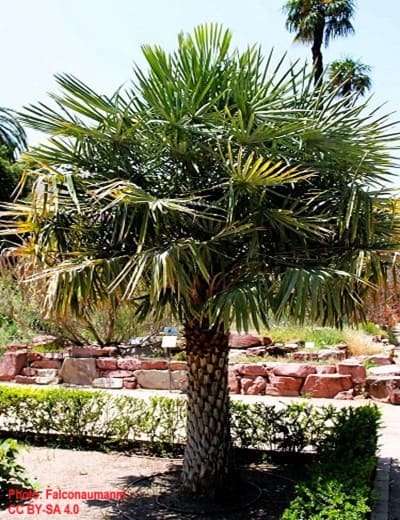 In Jardin Botanico de Valencia, in Spain
In Jardin Botanico de Valencia, in SpainSmaller Palm Trees For Subtropical Zones
Sunny Brazilian Need Palm
Trithrinax brasiliensis for Zones 9-11. Zone 8 in arid climates.
- Unusual trunk wound round with massive fibers. Like a winter coat!
- Best with full sun, lower water needs.
Clustering Backyard Palm Trees
for Your Subtropical Garden
Wanna Have a Cat?
Chamaedorea cataractarum, ideal Zones 10b-11. Protect from cold in 10a. Gets about 6ft/1.8m tall, spreading.
- Loves sun, lots of water.
- Tolerates shade. So it's used as an Indoor Palm.
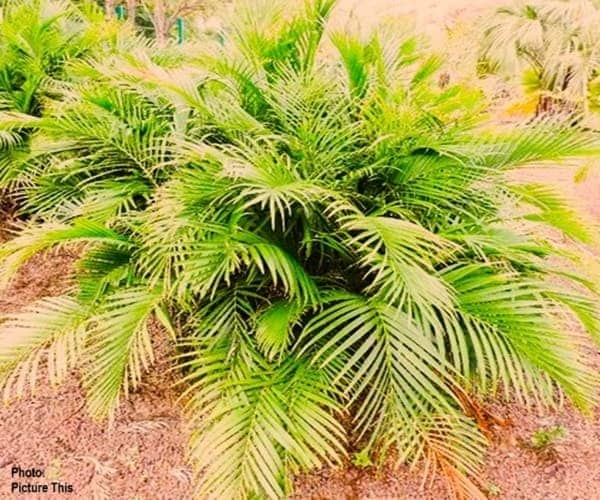 With feathery fronds, it works as a tall groundcover.
With feathery fronds, it works as a tall groundcover.Costa Rican Bamboo Palm
Chamaedorea costaricana, ideal Zones 10-11. Doable 9b with wintertime care.
- Likes some daily shade. Drinks up water!
- Gets 20ft/6m tall. Spreads 10ft/3m.
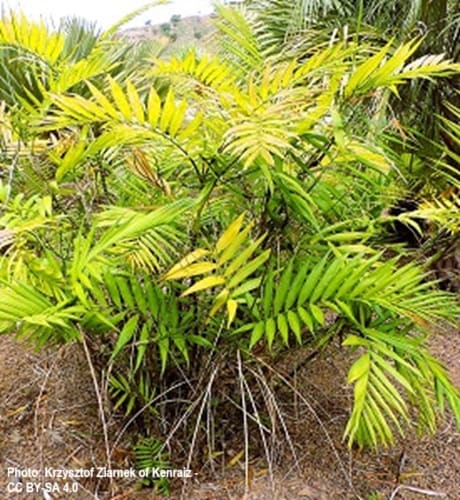 In Jardín Botánico Canario Viera and Clavijo
In Jardín Botánico Canario Viera and ClavijoOn Grand Canary Island
Meet the Lady
Rhapis excelsa's palmate fronds may remind you of a starburst! Great outdoor choice, yet it's most popular inside homes.
- Outdoors for Zones 9-11 & warm microclimates of 8b.
- Slowly to 12ft/4m tall.
- Some daytime shade, average watering.
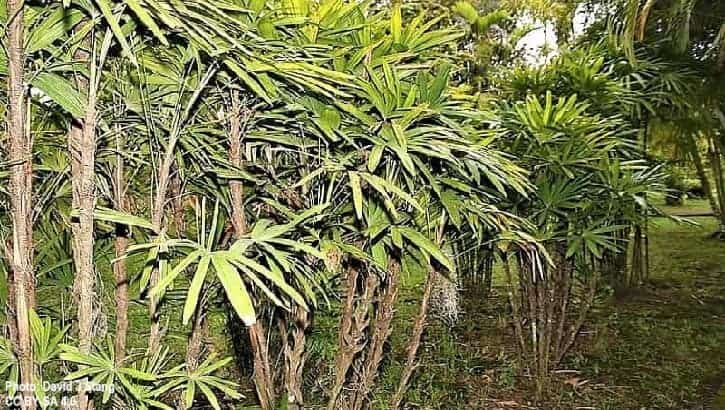
Best Palms for Temperate Zones
Temperate Planting Zones: 8 & lower.
- With the right palm in the right place, with the right care.
- Lowest temps about 10-20oF/-12-7oC.
Small Temperate Palms for Temperate Climes
Cold-Hardy Trithrinax campestris
Called the Blue Needle Palm, for Zones 7-11.
- Drought tolerant! Likes full sun.
- Grows to about 25ft/7.5m.
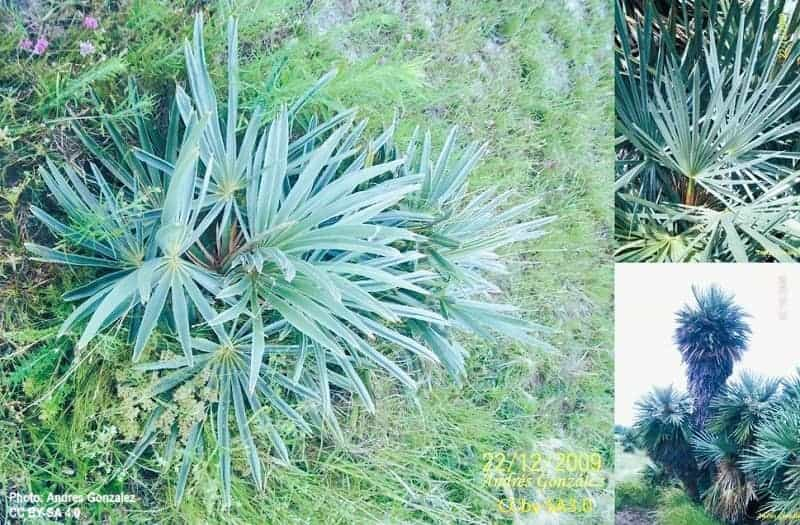 Also called Thatch Palm, Referring to its interesting trunk swirling with black fibers & spines.
Also called Thatch Palm, Referring to its interesting trunk swirling with black fibers & spines.Dwarf Palmetto for Shade
Sabal minor, AKA Bush Palmetto. Excellent for Zones 6-11, with caution: 5a.
- Trunk slowly grows mostly underground. Giving a short appearance.
- Loves wettest areas.
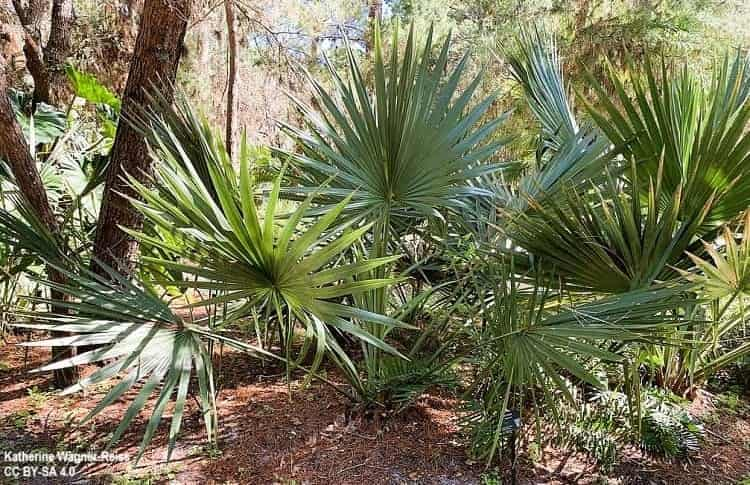 Pretty Fan Palms, Bush Palmettos Growing in Port St. Lucie Botanic Garden in Florida
Pretty Fan Palms, Bush Palmettos Growing in Port St. Lucie Botanic Garden in FloridaKumaon Palm in Sun & Cold
Trachycarpus takil, native to South China's Himalayan heights. Fine in Zones 7b-11. Experimentation ongoing for Zone 7a, 6, even 5!
- Maxes out at 46ft/15m.
- Likes sun, regular watering.
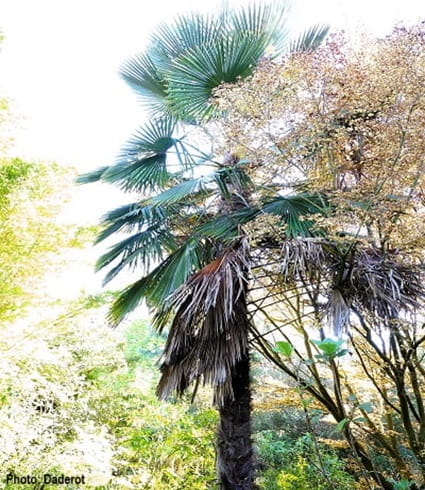 This Himalayan Palm Grows
This Himalayan Palm GrowsIn the San Francisco Botanical Garden
Best Tall Palm Trees in a Temperate Backyard Landscape
Popular Windmill Palm
Trachycarpus fortunei, AKA Chusan Palm & Chinese Fan Palm. Loved for cold-hardiness. Possible in Zones 7-11, even lower.
- Youthful windmills need protective action for colder temperatures.
- Likes sunlight, but some shade okay. Average watering.
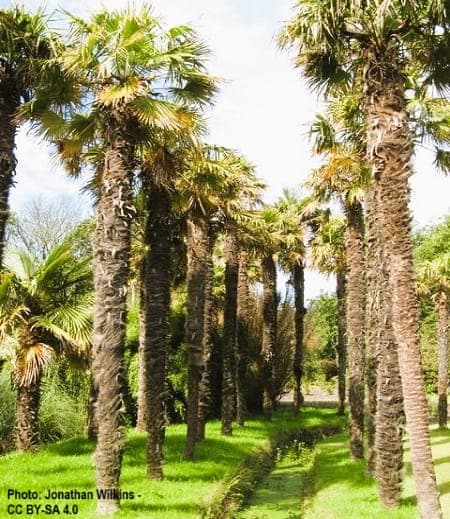 You'll See Why it's Called Palm Avenue!
You'll See Why it's Called Palm Avenue!Hardy Grove at Logan Botanic Garden in the UK
Cabbage Palm
Sabal palmetto, ideal Zones 8-11, possible 7b with winter care.
- Can grow 90ft/27m tall.
- Water regularly, or more for faster growth.
- Sun is fine, use shade cover if young.
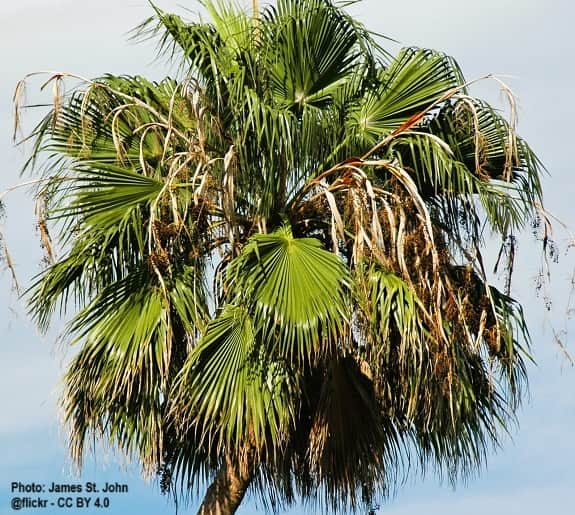 Often Just Referred to as a "Palmetto"
Often Just Referred to as a "Palmetto"They Have an Irresistible, Round Crown of Palmate Fronds.
California Fan Palm
Washingtonia filifera, called Cotton Palm in England. Does well in Zones 8-11, arid areas OK for 7.
- Can get 70ft/21m high. Likes sun, casual watering. Grows faster with a smidge more water.
- Likes keeping a leaf skirt.
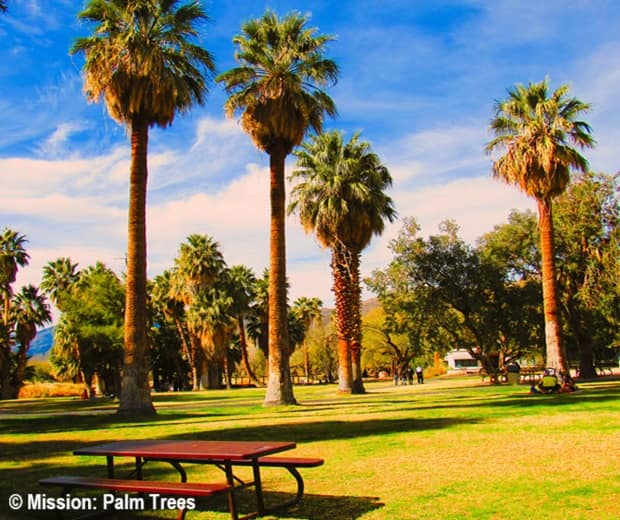 Washingtonia filifera Palms in a Tucson AZ park setting.
Washingtonia filifera Palms in a Tucson AZ park setting.Ideas for Backyard Clustering Palms For Temperate Areas
European Fan Palm aka Mediterranean Fan
Chamaerops humilis does well in Zones 8b-11, dryer parts of 8a.
- Spreads about 30ft/9m. To 20ft/6m tall.
- Sunny placement, lower watering.
Mazari Palm
Nannorrhops ritchiana, well suited in Zones 8b-11, with regular watering. 7-8a if rainfall scanty, in sunny backyards.
- Gets 20ft/6m tall.
- Spreads out to 15ft/4.5m.
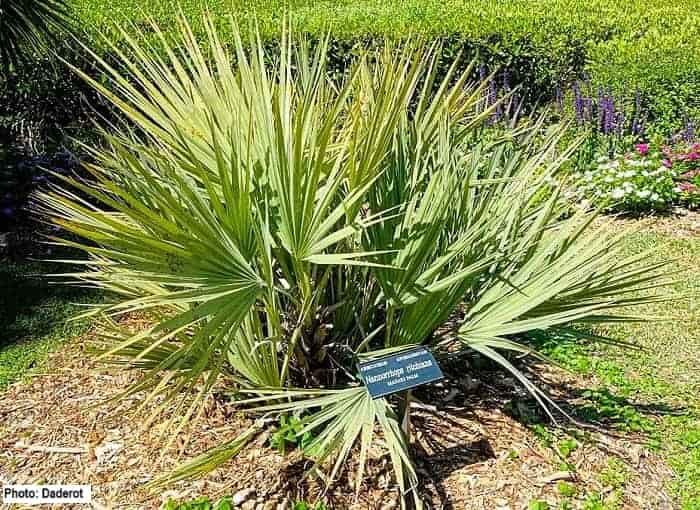 Picture-Perfect Mazari in Marie Selby Botanical Gardens, Sarasota FL
Picture-Perfect Mazari in Marie Selby Botanical Gardens, Sarasota FLUS southeaster native: Saw Palmetto
Serenoa repens, AKA Silver Saw Palmetto. Optimal Zones 8-11, milder microclimates of 7b.
- Can get 30ft/9m tall. Spreads out 12ft/4m.
- Subterranean trunks during youth, when it's slow-growing.
- Flexible for sunlight & watering.
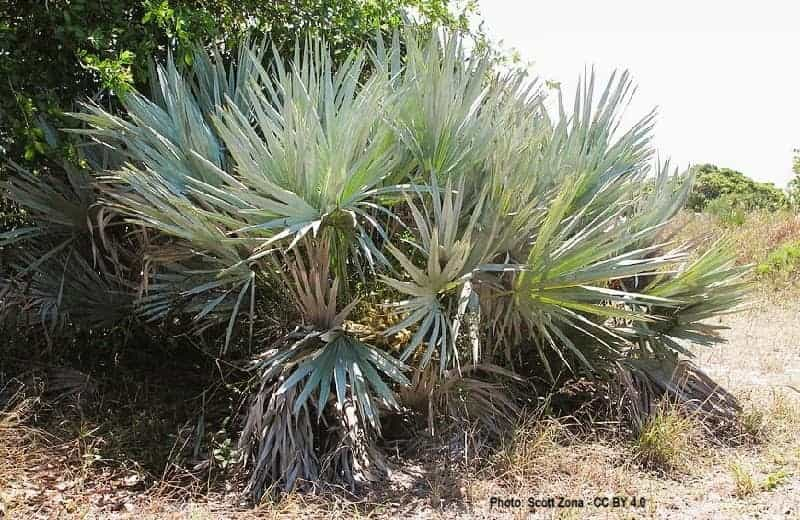 The Blue Form of This Serenoa repens Species
The Blue Form of This Serenoa repens SpeciesBest Palm Trees for Backyard - Takeaways
Did you find the best palm trees for your backyard, your landscape vision, your backyard dream?
The best palm trees for backyards depends on where you live.
- Tropical areas get their pick of palms.
- While non-tropical areas will present unique challenges. But give you equally unique rewards!
We hope your found your own best palm tree for the backyard!

